 |
 |
|
 |
|
 |
|
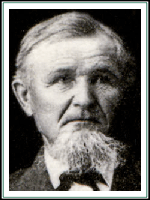 The very earliest of our family's
generations were generally given very basic educations in Germany. Perhaps the
pastor of the church taught reading or small makeshift schools existed
but many people would be illiterate for the most part. The very earliest of our family's
generations were generally given very basic educations in Germany. Perhaps the
pastor of the church taught reading or small makeshift schools existed
but many people would be illiterate for the most part.
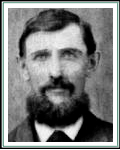 Before
August Heiden (left) and Heinrich Rambow (right) came to this country there was a movement to have
one room schools supported by local property owners. Bridge School in
Raisinville Township was a
prime example having been established as the first such school in
Michigan in 1828. Before
August Heiden (left) and Heinrich Rambow (right) came to this country there was a movement to have
one room schools supported by local property owners. Bridge School in
Raisinville Township was a
prime example having been established as the first such school in
Michigan in 1828.
Others in the family attended similar institutions
including nearby King
School or Fonia School. Generally, there was one teacher who taught all
8 grades plus kindergarten to the students in that single room. An 8th
grade education was the standard for most rural children back then.
In the late 1940s, school consolidation
became the trend and many of the one-room schools were brought together
into one large school district located in a nearby town. This was when members of our
family started taking a high school education for granted.
With the baby boom generation in the
1960s, it became more common for students to go on to post high school
training. Many of the later generations have taken advantage of college,
university or other educational opportunities.
|
|
|
|
|
 |
|
 |
|
 |
|
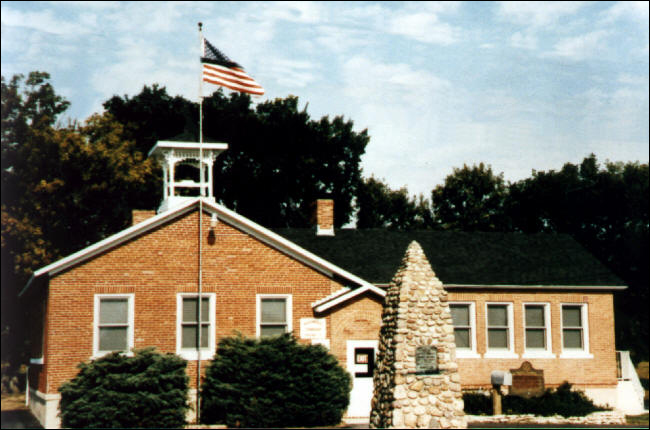 |
 |
|
|
|
|
|
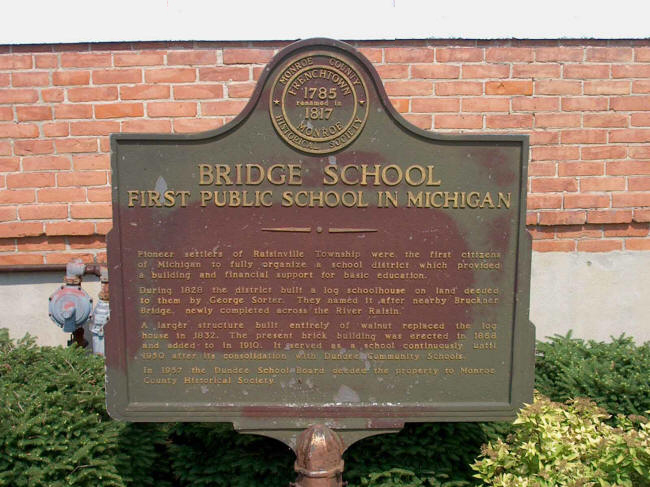 |
"Pioneer settlers of
Raisinville Township were the first citizens of Michigan to
fully organize a school district which provided a building
and financial support for basic education.
During 1828 the district
built a log schoolhouse on land deeded to them by George
Sorter. They named it after nearby Bruckner Bridge, newly
completed across the River Raisin.
A larger structure built
entirely of walnut replace the log house in 1832. The
present brick building was erected in 1858 and added to in
1910. It served as a school continuously until 1950 after
its consolidation with Dundee Community Schools.
In 1957, the Dundee School
Board deeded the property to Monroe County Historical
Society."
|
|
 |
|
 |
|
 |
|
|
|
The Bridge School served the
Raisinville Township community for a
very long time. In 1928, a big celebration was held to honor the
passing of the school’s 100th anniversary. A special pamphlet
titled, “100th Anniversary of Bridge School” was produced for the
occasion. The following is a summary of the history of school as it
appeared in that pamphlet. |
|
by S.E. Younglove
Monroe County Historian On April 7, 1828, after the meeting and elections for
Raisinville Township, a special meeting was held for the purpose of organizing
school districts. It was decided to have three districts more or
less of equal size based on the number of households. District One
was composed of Monroe Township. District Three was primarily in
Erie Township.
District Two would lay totally within
Raisinville Township. Its
boundary description was, “extending from the east line of the James Knaggs farm on the north side of the river, and the west line of the
Francis Farwell farm on the South side of the river, both running
west to the Indian Reservation and extending four and one half miles
back from the River Raisin on either side.” It was the first to
officially organize and begin the schooling of children.
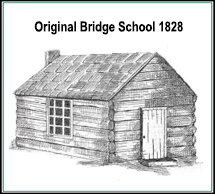 The first school house was built in 1828 on the west line of the
George Sortor farm, later known as the William Gibson farm. It was
made of logs from surrounding woodlots. Four years later in 1832,
the building was enlarged. Another expansion in 1843 was made of 2
inch thick black walnut planks. The first school house was built in 1828 on the west line of the
George Sortor farm, later known as the William Gibson farm. It was
made of logs from surrounding woodlots. Four years later in 1832,
the building was enlarged. Another expansion in 1843 was made of 2
inch thick black walnut planks.
By 1868, although the size of the district had been reduced, the
number of students was on the rise. It was then decided to construct
the brick building which remains as part of the current school. The
walnut school building was moved to the Ralph Zorn farm also known
as the Henry Younglove farm where it served as a tool and buggy
shed. In 1910, a brick addition was made on the north side of the
building.
The land on which the Bridge School stands passed through many hands
in history. In June, 1811, Oliver Wilson was patented a tract of
land extending from the River Raisin to the present village of Ida.
He transferred rights to 540 acres to Joseph Campeau who secured the
rights of the Indians to the tract for one flint lock shot gun and
one barrel of whiskey. In 1846, the land was sold to Bemis and Nogar
who in 1881 conveyed one acre of land to District Two. This is the
size of the site as it remains today.
From its beginnings, the school was open to all regardless of age.
In 1840 the age limit was placed at 21 with a small fee charged for
those between 21 and 24 who wanted to attend. The buildings were
always available for use by people of the community for social,
political, religious or business gatherings.
In the early days of the area, the only way across the river was by
means of an 18 foot long canoe hewn from an old cottonwood tree. It
was used to ferry people, livestock and goods. The first bridge, the
Bruckner Bridge, was built in 1828. At that time the area was
inhabited by the Pottawatomie and Wyandotte Indians under Chief
Tecumseh.
In 1828,
Raisinville Township offered a bounty of $2.00 for any wolf
killed in the township. Any person allowing a stallion to run at
large was liable for a fine of $10.00 but would only be fined $3.00
if they let a ram roam free. In 1833, the Supervisor of the Township
was allocated the sum of $20.00 for the care of the poor. He used
only $9.71 that year for the purpose.
|
|
|
 |
|
 |
|
|
|
 |
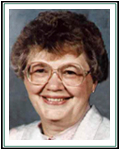  My
memories of Bridge School: One teacher taught all 8 grades. By
the time you reached the 8th grade one was quite knowledgeable
of all the subjects as you had heard it from day one in first
grade. So, consequently 8th graders could help the teacher by
listening to lower grades read their lessons. My
memories of Bridge School: One teacher taught all 8 grades. By
the time you reached the 8th grade one was quite knowledgeable
of all the subjects as you had heard it from day one in first
grade. So, consequently 8th graders could help the teacher by
listening to lower grades read their lessons.
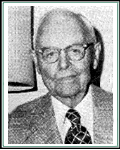 Recess was for
playing games such as Eenie Einie Over the garage roof, tag and
softball. I remember our team walking to
Stowell School on Dixon
Road [4.5 miles] to play a game and then walk back to Bridge
School again. We would play other country schools in softball
and compete in spelling bees. Recess was for
playing games such as Eenie Einie Over the garage roof, tag and
softball. I remember our team walking to
Stowell School on Dixon
Road [4.5 miles] to play a game and then walk back to Bridge
School again. We would play other country schools in softball
and compete in spelling bees.
Everyone brought
their own lunches to school and there was no cafeteria and no
free lunches like today. My first four years was taught by
Harrison Dentel
(right) (who also taught my father and the whole Heiden
clan). He married our dad's first cousin
Elsie (Rambow) Burgard
in 1926.
 He taught the
Palmer method of handwriting which was recognized by many people
in the business world in Monroe. I remember my first boss at
Monroe Bank and Trust as saying one could always recognize the
handwriting from anyone graduating from Bridge School. He taught the
Palmer method of handwriting which was recognized by many people
in the business world in Monroe. I remember my first boss at
Monroe Bank and Trust as saying one could always recognize the
handwriting from anyone graduating from Bridge School.
Mr Dentel was
teaching at Bridge School in 1928 when the monument was
dedicated for the centennial commemoration naming it the first
public school in Michigan.
I remember he had
good control of the students. You could hear a pin drop when
school was in session. He kept a leather strap in his desk that
kept control of some of the big farm boys who attended the
school.
 Walter W. Grams was my teacher for the last four years at Bridge
School. He was a great teacher and because I was older I
probably remember him better. He ran the school much the same as
Harrison Dentel. He bought three acres from our Grandma and
Grandpa Heiden [Wm Carl and Mary (Rambow) Heiden] and they built a house
directly across from the Heiden homestead on
Dixon Rd. Your
mother and dad [Mildred (Roggerman) and Arthur Heiden] eventually lived
there but not sure of the years. Walter W. Grams was my teacher for the last four years at Bridge
School. He was a great teacher and because I was older I
probably remember him better. He ran the school much the same as
Harrison Dentel. He bought three acres from our Grandma and
Grandpa Heiden [Wm Carl and Mary (Rambow) Heiden] and they built a house
directly across from the Heiden homestead on
Dixon Rd. Your
mother and dad [Mildred (Roggerman) and Arthur Heiden] eventually lived
there but not sure of the years.
Also, when someone
in the school district passed away, the teacher would lead
everyone single file to the home of the deceased to pay respect.
Most everyone was laid out at the home in those days rather than
a funeral parlor and they were within walking distance of the
school.
 Every morning
someone would raise the American flag and then ring the bell for
9:00 a.m. school to begin. The bell was rung for every recess
and lunch hour too. The teacher would come early in the morning
and get the furnace started so it would be warm when the
students arrived. The kids would be cold in the winter months
when they got to school so everyone stood on the large floor
register to get warm before starting classes. Every morning
someone would raise the American flag and then ring the bell for
9:00 a.m. school to begin. The bell was rung for every recess
and lunch hour too. The teacher would come early in the morning
and get the furnace started so it would be warm when the
students arrived. The kids would be cold in the winter months
when they got to school so everyone stood on the large floor
register to get warm before starting classes.
The teacher also
did all the sweeping and dusting of the school. At the end of
each school day the older kids would wash the large blackboard
which ran the whole length of the west wall. Everyone would take
turns clapping together the erasers outside to clean them.
After this we would all walk home. For some it was over a mile
walk.
There was a parent teachers meeting once a month at the school
with parents and students. Sandwiches and coffee were served.

The move from Bridge School to Dundee Community
School was not always smooth. When I was 5 years old in 1947,
they bussed me to Dundee for Kindergarten. The next year, I was
bussed to Macon school for first grade and then back to Bridge
school for second grade. For third grade, I took the bus to
Dundee and was transferred to another bus to go to White school.
Finally, from fourth grade onward, we went to Dundee.
 We
have more
remembrances of Bridge School in the family memories
section. We
have more
remembrances of Bridge School in the family memories
section.
|
|
|
 |
|
|
 |
|
 |
|
|
|
 |
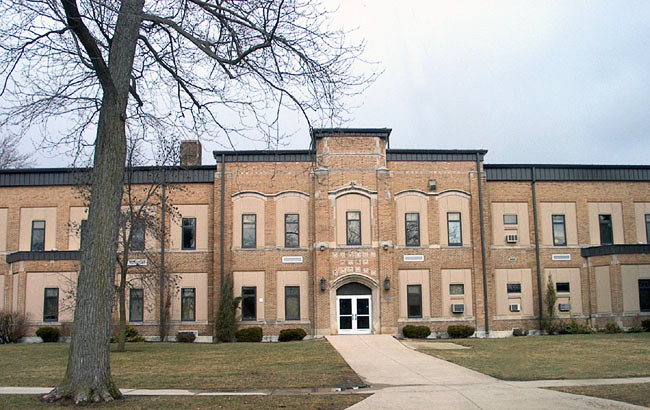 |
|
 |
|
Although all 13 of Wm Carl and Mary
(Rambow) Heiden's children completed the 8th grade at Bridge School,
only 2,
Wilma (Heiden) Bicking and
Norma "Jeanie" Heiden went on to attend high school in
Dundee. In those days, an 8th grade education was considered enough
for most people to find a job or to work on the farm. It was not
easy for students to move on to the next level of education in those
days.
 High schools were located in the towns
such as Dundee and Ida and there was no free
bus service then to carry distant students to school each day. People who
wanted to attend had to arrange for their own transportation and
this was not always easy. Most students had to pay for their rides
or share the cost of commuting and the money for this was not always
available. In the early part of the twentieth century, even some public schools
charged tuition fees and many of them required the student to pass
entrance exams. High schools were located in the towns
such as Dundee and Ida and there was no free
bus service then to carry distant students to school each day. People who
wanted to attend had to arrange for their own transportation and
this was not always easy. Most students had to pay for their rides
or share the cost of commuting and the money for this was not always
available. In the early part of the twentieth century, even some public schools
charged tuition fees and many of them required the student to pass
entrance exams.
|
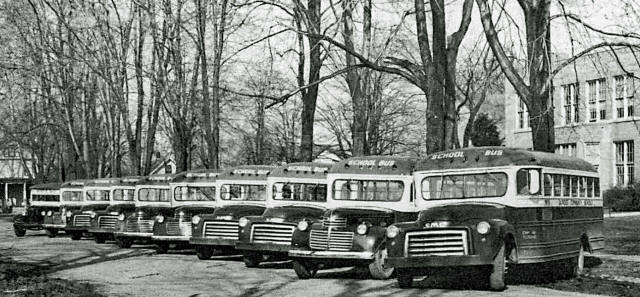 |
|
By the late 1940's, the movement in education was toward closing
down the one-room schools and consolidating them into larger,
community school districts. In 1946, Bridge School ended its long
existence as a place of learning. The Raisinville District No. 2 was
incorporated into the Dundee Community School District and an
extensive bus system was initiated to carry students into Dundee
each day. Some of the students from the Bridge, King or Fonia School also attended
Ida Public Schools in nearby Ida.
|
 |
|
 |
|
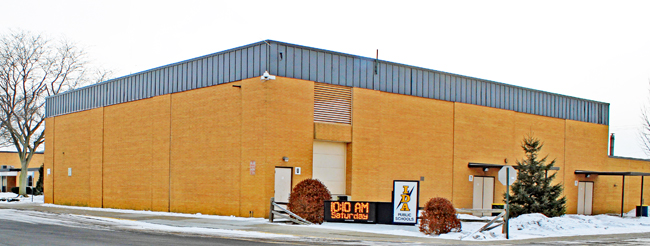 |
|
|
|
 |
|
 |
|
 |
|
 |
|
We only have data through the
1995 The Heiden Family book but
even by then, members of the
Wm Carl and Mary
(Rambow) Heiden family or their
spouses had attended 43 different colleges and universities. Obviously,
this list would be greatly expanded now, thirty years later.
|
- Albion College
- Algonquin University
- Alma College
- Arizona State University
- Central Michigan University
- Cleary Business College
- Detroit Business College
- Eastern Michigan University
- Ferris State University
- Hillsdale College
- Kellogg Community College
- Liberty University
- Louisiana Tech University
- Madonna University
- Miami University
- Michigan State University
- Michigan Technological University
- Millersville University
- Mohawk College
- Monroe County Community College
- Mount Allison University
- Northeast Louisiana University
|
- Northern Kentucky University
- Northern Michigan University
- Northwestern University
- Oakland Community College
- Oakland University
- Olivet Nazarene University
- Oswego State University
- Point Loma Nazarene College
- Purdue University
- Ryerson Polytechnical University
- St John Fisher College
- University of Cincinnati
- University of Detroit
- University of Illinois
- University of Michigan
- University of Ottawa
- University of Toledo
- University of Utah
- Wayne State University
- Western Michigan University
- Xavier University
|
|
 |
|
|
|
|
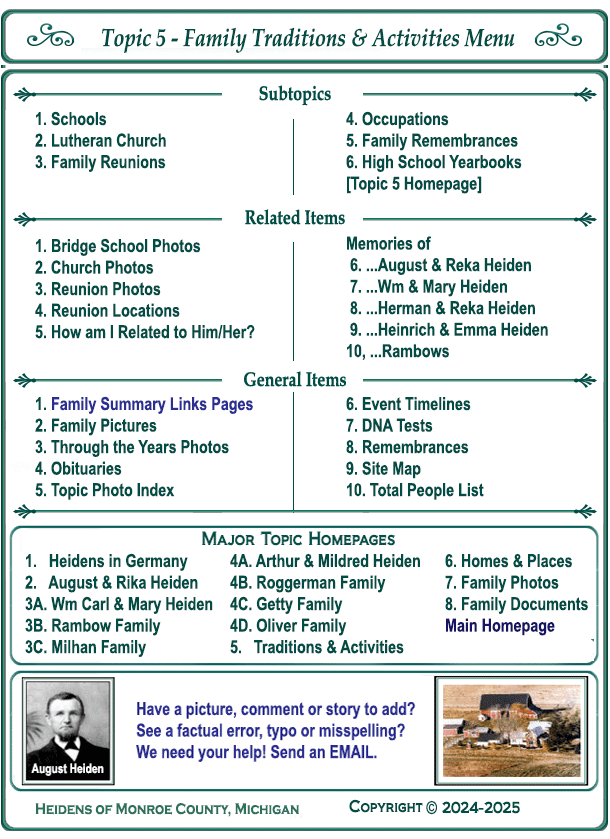
|
 |
 |

